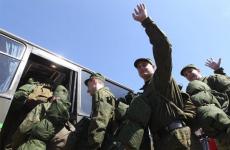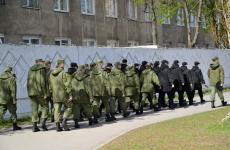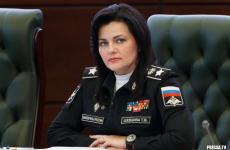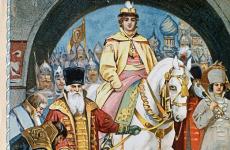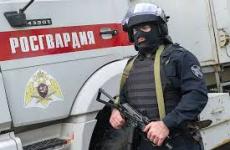Combat route 1185 regiment of the 356th rifle division. Cesis
During the Riga operation:
- 80th Rifle Corps -
Major General Avts. Butorin Tikhon Ivanovich
- 356th Rifle Division - Major General Makarov Mikhail Grigorievich
- 51st Separate Tank Regiment - Lieutenant Colonel Mzhachikh Petr Grigorievich
- 1899th self-propelled artillery regiment - Major Vinogradov Mikhail Kirillovich
On September 26, 1944, on the outskirts of the city of Cesis, the enemy managed to stop the regiments of the first echelon of the 212th Infantry Division advancing on Cesis with their counterattacks. The enemy launched several counterattacks against the 356th rifle division, advancing to the left of the 212th Infantry Division, but to no avail. Regiments of the 356th Infantry Division broke through the enemy defenses near Veselava village, repulsed four counterattacks and moved forward, starting a battle beyond Priekule, where two more enemy counterattacks were repulsed.
The 356th Rifle Division, together with the 51st Rifle and 1899th Self-Propelled Artillery Regiments, created mobile observation posts from scouts in each unit to fight the counterattacking enemy. Being in the forward advancing battalions, tank companies and self-propelled artillery batteries, they had to, having noticed the advance of the counterattacking enemy, transmit the coordinates of the targets by radio in plain text. Artillerymen with radio stations specially assigned to receive these transmissions were supposed to receive reports about the counterattacking enemy and quickly open fire on him. Tanks and self-propelled guns of the advancing, having received a signal, also had to be prepared in a timely manner to repel a counterattack. As a result of the measures taken, the three major enemy counterattacks planned near Cesis by the division were thwarted. The counterattacking battalions of the enemy, having barely begun to advance, fell under friendly and timely open fire from artillery, tanks and self-propelled artillery installations, suffered losses and dispersed.
In front of the city of Cesis, enemy positions passed along the embankment railway and highway. 51st Tank Regiment, advancing north of the highway from Cēsis to Rauna overcame these positions. The crews of two tanks were the first to break into the city, they noticed enemy machine gunners at the intersection of streets north of the railway station. Obviously, they were waiting for the approach of our units in order to immediately counterattack them. The tankers scattered the Nazis with machine-gun fire and began to slowly move along the streets, followed by other tanks of the regiment from the north.
Following the tank regiment, the 669th broke into the city. rifle regiment 212th Rifle Division, which, recovering from enemy counterattacks, broke his resistance. Groups to fight the enemy, seated in strong points, interacting with tanks, destroyed enemy firing points, cleared the way for the advance of rifle companies.
The 1899th self-propelled artillery regiment at that time was advancing in combat formations of the 1183rd rifle regiment of the 356th rifle division to the central part of Cēsis. The regiment was unable to overcome the enemy's fire resistance, leaving several self-propelled guns to suppress the firing points, began to bypass the strongholds to the north and, passing in the lane ahead of the advancing 51st Tank and 669th Rifle Regiments, entered the city, where it began street fighting. The appearance of tanks and self-propelled guns in the city forced the enemy to begin a retreat.
advancing in the direction of the station and the center The 1181st Rifle Regiment also broke into the city. The 1st battalion of the regiment fought for quarters near the station. The enemy met them with machine-gun fire, but soon withdrew. Pursuing the retreating Nazis, the company headed through the city. Approaching him western outskirts, she overtook the retreating enemy and, after a short battle, captured about fifty fascists.
Southern part of the city liberated the 1185th rifle regiment and two batteries of the 1899th self-propelled artillery regiment. Self-propelled gunners moved in chains of advancing shooters, destroying every firing point that interfered with their advance. Part of the self-propelled guns, along with the arrows, entered the city, others began to bypass it along the outskirts. The enemy Ferdinand assault guns in ambush set fire to two of our self-propelled guns. The arrows advancing nearby pulled out the dead and wounded from the burning self-propelled guns. Enemy assault guns continued to fire on the advancing. Bypassing the enemy ambushes, the platoons destroyed the enemy infantry, covering the assault guns, left without cover, the artillerymen withdrew.
The regiments of the 356th rifle division, having passed the city, by 13 o'clock cleared it of the enemy, captured over two hundred enemy soldiers and officers. The regiments advanced to the river Gauja, where they were stopped, since by order of the commander of the 80th rifle corps, the 356th rifle division was withdrawn to its second echelon.
 The military fraternal cemetery is located on Lenču Street, 100 meters south of the Forest Cemetery, in the city of Cēsis.
The military fraternal cemetery is located on Lenču Street, 100 meters south of the Forest Cemetery, in the city of Cēsis.
There is a monument on the north side of the cemetery. The inscription on the group of commemorative plates: “FRATURAL CEMETERY OF THE DEAD SOVIET SOLDIERS. 1941 - 1945. KRITUŠO PADOMJU KARAVĪRU BRĀLU KAPI.
CASE OF KIRYUKHIN
This case is unique in that the disappearance of a soldier does not occur here on the battlefield, or, as is very often the case, not on the way from the unit to the medical battalion or hospital, but on the way from the NKVD investigators to the unit. Where did Private Kiryukhin disappear to? We need to resolve this matter.
Private Kiryukhin Grigory Prokhorovich was born in 1904 and lived in the village of Ushakovo-Pokrovskoye, Plavsky district, Tula region (now this village does not exist). Since 1932, a collective farmer of the Krupskaya collective farm. In 1939-40. He was called to the front and participated in the Soviet-Finnish War as part of the 662th Infantry Regiment, demobilized in August 1940. In 1940, his wife Anna Arkhipovna died, leaving four daughters: Maria 1929, Tatyana 1932, Alexandra 1934, Claudia 1939, Mother - Praskovya Matveevna Kiryukhina, born 1881.
With the beginning of the Great Patriotic War Grigory Prokhorovich was not called to the front. He was mobilized after the liberation of Plavsk, on May 26, 1942, and in July-August he served in the 6th company of the 1181 joint venture.356 SD . Private, non-partisan, had no awards.
In August 1942, he was detained by a foreign detachment in connection with the discovery of German leaflets in his wallet, then he was in custody. In September, the charges were dropped by the 356 SD military tribunal and he was released. Further fate and place of service after August 1942 are unknown.
Reported missing since August 1943, which was established only according to the post-war house-to-house survey, which indicated that communication ceased in May 1943 (no letters have been preserved).
Note: the full namesake is Grigory Prokhorovich Kiryukhin, also born in 1904. and also a native of the Plavsky district (another village, Pokrovskoye-Kamynino), called up in 1941 and died in 1945.
Investigation. The first stage of the investigation was conducted by the grandson of the missing person, Timur Maisak. It is a great success that the materials of the investigative case, which was carried out in relation to Kiryukhin, have been preserved. Here is what is reported in the certificate of the Tula FSB.
On August 13, 1942, Kiryukhin G.P., upon returning from foot reconnaissance, was detained by the Red Army detachment. During a search, 2 German leaflets were found in his possession. On August 21, 1942, the investigator of the NKVD 356 SD Kiryukhin was involved as an accused under article 58-10 part 2 of the Criminal Code of the RSFSR. During the investigation, it was found out that the leaflets were used by Kiryukhin only as smoking paper. Kiryukhin was characterized positively by the materials of the investigation.
By the definition of the military tribunal 356 SD OT on September 12, 1942, the case against Kiryukhin was dismissed due to the lack of corpus delicti with immediate release from custody.
Interestingly, according to the certificate issued by the TsAMO of the Russian Federation, there is an error, it says that Kiryukhin on September 12, 1942only brought to justice. Although it is also reported that“the case was criminally terminated”, “the supervisory proceedings in the Kiryukhin case were destroyed due to the expiration of the storage period”, the terminated criminal case was not deposited in TsAMO RF (of course, because it is stored in the Tula UFSB).
Kiryukhin G.P. (from the criminal case)
Case No. 361-42
MINUTES OF THE PREPARATORY MEETING
MILITARY TRIBUNAL 356 PAGE DIVISIONS.
1942 September 12 days.
Presiding Military Lawyer Komarov,
members: Military lawyer 3rd rank Zakharov and Military lawyer Nekorystnov, secretary Kryuchkova,
with the participation of the Military Prosecutor 356 pp. divisions.
Case No. 361, received from the VP 356 SD, on charges of a Red Army soldier of 1181 sp. Kiryukhin Grigory Prokhorovich, in the commission of a crime under Art. 58-10 h. 2 of the Criminal Code of the RSFSR, with an indictment drawn up by the investigator of the NKVD OO 356 SD - lieutenant of state security Kiselev and approved by the Military Prosecutor of the 356 SD military lawyer of the 2nd rank Bykov.
Reporter Bykov.
Co-speaker Komarov.
SET UP:
From the case file it is clear that Kiryukhin, being in 215 Z.S.P. due to the lack of smoking paper, he smoked fascist leaflets, which continued in 1181 S.P. but in view of the receipt of smoking paper, Kiryukhin kept two fascist leaflets for use in smoking and kept them together with smoking paper in his wallet, which were found on August 13, 1942.
The materials of the preliminary investigation did not establish: did Kiryukhin read fascist leaflets to anyone, did he tell them content On the contrary, Kiryukhin's testimony shows that he kept the leaflets for smoking and forgot about them.
Based on this, the court does not see in the actions of Kiryukhin the counter-revolutionary intent of storing leaflets - a crime under Art. 58-10 h. 2 of the Criminal Code of the RSFSR.
The materials of the case characterize Kiryukhin as a good fighter.
Based on the aforesaid and guided by Article. 238 Code of Criminal Procedure of the RSFSR.
DETERMINED:
The case on charges of Kiryukhin Grigory Prokhorovich, under Art. 58-10 h. 2 of the Criminal Code of the RSFSR, on the basis of Art. 4, paragraph 5 of the Criminal Code of the RSFSR, terminate further proceedings with the immediate release of Kiryukhin from custody.
Chairman /Komarov./
Secretary /Klochkova./
TO THE CHIEF OF THE NGO NKVD 356 SD.
At the same time, I am sending a copy of the ruling on the case of Grigory Prokhorovich KIRYUSHKIN, who is being held in your custody, I propose that Kiryushkin be immediately released from custody and sent to the Military Tribunal
Appendix: A copy of the definition.
AND ABOUT. CHAIRMAN TU 356 SD
Military lawyer /Komarov./
Secretary /Klochkova/
Issued to the Military Tribunal 356 SD that Kiryukhin Grigory Prokh. released by permission of the NGO NKVD on September 15, 1942.
Commandant of the NGO NKVD
TO THE HEAD OF DIVISION 4
At the same time, I am sending the Red Army book of KIRYUKHIN Grigory Prokhorovich, the case against him was terminated.
Appendix: Kiryukhin's Red Army Book.
CHAIRMAN BT 356 SD /Rossiev/
Secretary /Klochkova//.../
In addition, he qualitatively checked the funds of 356 SD and 1181 SP 356 SD. I myself rechecked the work of T. Maysak and highlighted some documents that are not issued to the reading room, but for which, in my opinion, it is necessary to make a request, namely:
Headquarters 356 SD 1 inventory
case 133 Instructions, reports and reports of the military commissar and the head of the software division for party political work and emergency, 1942
case 134 Political reports of the division. I ordered this case, but they may not give it, political reports are sometimes not given.
case 135 Reports, reports, data of the department on party political work, work among the troops and the population of the enemy, beginning. composition and state of emergency, political reports
case 136 Reports of employees of the department and units on party-political, Komsomol work with the troops and population of the enemy
case 137 Same for the emergency
According to the materials presented above, it is clear that Kiryukhin was still alive in mid-September 1942. The 4th department of the division headquarters - this department in the Red Army, traditionally, was a combatant.
In general, you need to look at the materials throughout the division. Let's see what it included:
1181
, 1183 and 1185 rifle regiment,
918 artillery regiment,
275 separate anti-tank battalion,
417 reconnaissance company,
483 sapper battalion,
806 separate communications battalion (806 separate communications company),
440 medical battalion,
433 separate company of chemical protection,
470 motor transport company,
***
209 field bakery,
779 divisional veterinary infirmary,
286 field post station,
785 field cash desk of the State Bank.
The materials of the 1181th Infantry Regiment have already been reviewed, in addition, below are the units that usually do not have their own funds in the TsAMO RF, they can be excluded. In addition, divisional documents are well reviewed. We'll watch the rest.
D Olgov Nikolai Ivanovich - commander of the intelligence department of the 356th rifle regiment (343rd rifle division, 50th army, 3rd Belorussian Front), senior sergeant - at the time of presentation for awarding the Order of Glory 1st degree.
Born March 25, 1918 in the village of Verkhnyaya Yaroslavka, now Sosnovsky District, Tambov Region, in a peasant family. Russian. Graduated from 7 classes. He worked as an accountant on a collective farm.
In the Red Army since 1938. Member of the campaign of Soviet troops in Western Ukraine and Western Belarus in 1939. In the army during the Great Patriotic War since July 1941. As part of a cavalry regiment, he fought in Belarus, was surrounded. Making his way to the front line, he reached the Smolensk forests and was enlisted as a demolition officer in one of the partisan detachments. After joining the detachment with the Soviet troops, he was again drafted into the army.
The commander of the reconnaissance section of the 356th Infantry Regiment (343rd Infantry Division, 49th Army, 2nd Belorussian Front), Senior Sergeant Dolgov, on September 14, 1944, near the city of Novogrudok (Poland), together with scouts, secretly made his way to enemy trenches and fire from machine gun hit eight enemy soldiers. After the failure of the commander, he took over the leadership of the platoon and clearly exercised control in battle.
By order of the commander of the 343rd Infantry Division of September 20, 1944, Senior Sergeant Nikolai Ivanovich Dolgov was awarded the Order of Glory 3rd degree (No. 198352) for courage shown in battles with the enemy.
On February 12, 1945, being part of the same regiment and division (50th Army), in the battle for the village of Frazendorf (56 kilometers south of the city Koenigsberg) was among the first to come into contact with the enemy, destroyed two Nazis, took one prisoner.
By order of the 50th Army of March 23, 1945, Senior Sergeant Dolgov was awarded the Order of Glory, 2nd degree (No. 14180).
On April 8, 1945, the commander of a foot reconnaissance platoon, fighting as part of the same regiment, division and army (3rd Belorussian Front), during the assault on the city and fortress of Königsberg (Kaliningrad), senior sergeant Dolgov, as part of an assault battalion, captured a well-fortified fort with a sudden attack . At the same time, a group of Nazis was liquidated and fourteen soldiers and officers were captured. The enemy tried to regain lost positions. Scouts under the command of Dolgov participated in repelling three enemy counterattacks and disabled about twenty Nazis.
At By order of the Presidium of the Supreme Soviet of the USSR on May 15, 1946, for courage, courage and heroism shown in the fight against the Nazi invaders, the senior sergeant was awarded the Order of Glory 1st degree (No. 1239).
Demobilized after the war. He returned to his native village, worked at the Yaroslavsky state farm. Died in 1992.
He was awarded the Orders of Glory 1st, 2nd and 3rd degree, two Orders of the Patriotic War 1st degree, the Order of the Red Star, and medals.
(provided by the former head of the Local Lore Museum of the Kinel-Cherkasy Secondary School No. 1 Shenkevich V.I.)
Born October 14, 1915 in the village of Krasnokutsk, Kharkov region in a poor peasant family.
My parents - father Fyodor Andreevich and mother Anissia Grigorievna - came from serfs, in early age died in 1925, at that time I was in school in the second grade, my brother Ivan, born in 1910, was employed by wealthy peasants, my mother's grandmother, born in 1831, lived with us. Those were the most difficult years of my survival.
After graduating from the seven-year plan, he entered a general technical school with a degree in construction technicians. In 1931 he joined the Komsomol, took an active part in public work on grain procurement in his Krasnokutsk region. After graduating from college, he worked in the city of Kharkov at various civil production construction sites, as a technician until 1935. In 1935, on a Komsomol ticket, he left for the construction of the city of Komsomolsk-on-Amur, where he took part in the construction of a railway station, one of the largest radio stations in the Far East, as well as military facilities. In 1938 he was drafted into the Red Army and served in the First Separate Red Banner Far Eastern Army, which was then commanded by Marshal Soviet Union V.K. Blucher, whose headquarters was in the city of Voroshilov (formerly the city of Nikolsko-Ussuriysk).
In 1940 he was sent to study at the Moscow Red Banner Infantry School named after the Supreme Soviet of the RSFSR. The Great Patriotic War found me in this school. After the parade on Red Square on May 1, 1941, reorganization began at the school. The 4th cadet company, in which I studied, was urgently sent to the summer camp of the Podolsk machine-gun and mortar military school, which studied mainly the theory and practice of mortar business. On September 1, 1941, by order of the Minister of Defense of the USSR No. 100, we were awarded military ranks - lieutenants, and we all dispersed to military units. Some of the graduates, including myself, were sent to the headquarters of the Volga Military District in Kuibyshev, where the 356th Rifle Division was formed in the region. Its rifle regiments were located: 1181SP - p. Kinel-Cherkassy, 1183SP - p. Borskoe, 1185SP - p. Rich, division headquarters - Kinel. I was sent to the 1181st Rifle Regiment as commander of the 2nd mortar company of the mortar battalion. In November 1941, the 356th Rifle Division left for the active army and on December 17, 1941, at the turn of the Beautiful Sword River, the city of Efremov, Tula region, joined the battle against the fascist invaders, so from that day my front-line life began. He took part in the fighting for the liberation of the cities: Efremov, Belev, Chern and many settlements of Tula and Oryol regions. In May 1942, in a combat situation, he was admitted to the ranks of the Communist Party.
On February 22, 1943, in a fierce battle in the direction of the city of Bolkhov, Oryol region, he was seriously wounded in both legs and was treated at hospital No. 2928 in Gorky. On May 5, 1943, after treatment, he arrived at the Main Directorate of Personnel of the Ministry of Defense of the USSR, where he was sent to the Higher Advanced Training Courses for Infantry Officers "Shot" named after. Marshal of the Soviet Union B. M. Shaposhnikov, the city of Solnechnogorsk, Moscow Region. After completing the course on January 10, 1944, he left for the 4th Ukrainian Front in the 3rd Guards Army, which led fighting for the city of Nikopol, and its headquarters was located in the village. Mikhailovka, and the commander of the army was appointed commander of an officer company of political officers for the preparation and training of them for the positions of commanders of rifle companies. In March 1944, the 3rd Guards Army was transferred to the 1st Ukrainian Front in the Rivne region. In June 1944, after graduating from my students, he was appointed commander of the 3rd assault battalion in the 658-1 rifle regiment of the 219th Romodan-Kyiv, Red Banner, Order of Suvorov II degree rifle division, which fought stubborn battles for capturing the city of Vladimir-Volynsky. On June 25, 1944, the second battalion was the first to cross the river. Northern Bug in the Ustilug region, and entered the territory of Poland with a fight. In the future, at the forefront of the regiment, fighting with the enemy. By August 1, 1944, he reached the line of the Vistula River near the village of Valovitsa, and on August 3, the battalion crossed the river. Vistula and fought for the capture of a bridgehead on the western bank of the river. On August 6, the battalion fought a fierce hand-to-hand fight with fascist penitentiaries, in this fight I was wounded for the third time and was treated in the 368th medical battalion of the 218th SD. On August 25, after finishing treatment, I returned to my battalion and took up defense at the Sandomierz bridgehead .
From January 12 to 13, 1945, the general offensive of the troops of the 1st Ukrainian Front began in the direction of Berlin. In these battles, I took part in the capture of the city of Liegnitz, in the crossing of the Oder River, surrounded by a large group of fascist and Vlasov troops in the city of Breslavl, where on February 20 I was wounded for the fourth time and until April 1, 1945 I was treated in army hospital No. 2903 Strize, Germany. After treatment, he returned to his battalion, continuing to fight to destroy the fascist group of troops in Breslavl until the end of the war.
On June 30, 1945, 218 SD was disbanded with a new name, the Order of Lenin was added to its title, for military merit in the destruction of the Breslav group of fascist troops. After the division was disbanded, I remained in the ranks of the Soviet Army and, with a group of officers, was sent to a one-year advanced training course for officers in the Central Group of Forces, which was located in Austria, with headquarters in Baden, and courses in Dreiskirchen. After completing the course, he was appointed commander of a separate training battalion for the training of sergeants for the rifle units of the 4-1 Guards Division, which was stationed in Austria with headquarters in Neukirchen.
 After a long separation from the war in November 1946, my wife Maria Kuzminichna arrived at my place of service. In June 1947, the 4th Guards Division disbanded, and I was appointed deputy commander of the 127th separate escort battalion. To escort various cargoes to the Soviet Union, the battalion was stationed in Rinner Neustadt, Austria. On September 15, 1947, our daughter Nina was born in the city of Vienna. In March 1948, I was appointed commander of a group of troops as a battalion commander in the 182nd Infantry Regiment of the 95th Guards Division, which was stationed in Austria - its headquarters was in St. Polten, and the headquarters of the 182nd S.P. . Badfishau.
After a long separation from the war in November 1946, my wife Maria Kuzminichna arrived at my place of service. In June 1947, the 4th Guards Division disbanded, and I was appointed deputy commander of the 127th separate escort battalion. To escort various cargoes to the Soviet Union, the battalion was stationed in Rinner Neustadt, Austria. On September 15, 1947, our daughter Nina was born in the city of Vienna. In March 1948, I was appointed commander of a group of troops as a battalion commander in the 182nd Infantry Regiment of the 95th Guards Division, which was stationed in Austria - its headquarters was in St. Polten, and the headquarters of the 182nd S.P. . Badfishau.
In view of the intensification of an unfriendly policy on the part of some imperialist countries led by the USA against the USSR, a world cold war was born and gained momentum. By the decision of the Soviet Government, all the wives of military personnel with children were urgently taken out, this happened in my family in August 1948. In November 1948, for further service, I was transferred to Hungary in the 17th mechanized division, in the 80th tank regiment, as commander of a battalion of submachine gunners. On September 16, 1950, by order of the Minister of Defense No. 02088, I was awarded the military rank of lieutenant colonel. The 17th mechanized division with its headquarters was located in the city of Szombathely. On March 10, 1951, I received a joyful message, a replacement arrived from the Soviet Union, after the transfer of the battalion on March 15, I left for the Belarusian military district, Lida, Grodno region. In the 48th Guards Rifle Division, where he was assigned to the 138th Rifle Regiment as commander of the 2nd Battalion, the regiment was stationed in Novogrudok. Here I joined my long-awaited family.
On November 1, 1957, by order of the commander of the Belarusian Military District, he was sent to the Northern Military District of Murmansk, to the 116th Infantry Division, the 84th Infantry Regiment for the post of battalion commander, the regiment was located in the settlement of Kildin-Stroy, sixteen kilometers from Murmansk. Here my service in the Soviet Army ended, by order of the Ministry of Defense No. 0358 of March 5, 1959, under Article 50, point “B”, I was transferred to the reserve due to illness.
After demobilization, he came to Kinel-Cherkassy with his family for a permanent place of residence. During the period of his life in Kinel-Cherkassy, he took an active part in social work, life and development of the village: he was elected a deputy of the 2nd Village Council 10 times, he was the chairman of the commission for socialist legality and the protection of public order, the chairman of the commission for assistance to the family and school, the chairman of the Comrades' Court, the head of the methodological association of military instructors of the district, a member of the party commission of the District Party Committee. From 1971 to 1984 he worked as a teacher of elementary military training at the second school.
For military merits during the war years and military service, he received four thanks from the Supreme Commander-in-Chief Comrade I.V. Staoin: for the liberation of the city of Vladimir-Volynsky, for crossing the river. Vistula, for crossing the Oder River, for taking the city of Breslavl.
Awarded with orders: Red Banner, Alexander Nevsky, World War I degree, Red Star. Medals: For Military Merit, For Victory, Labor Veteran, For Impeccable Service, 1st Class, 11th Anniversary Medals, as well as Badges of Honor: Veteran of the 61st Army, Soviet Committee of War Veterans, All-Union Society DOSAAF. For good performance in combat and political training, the battalion was awarded three hours, some of them nominal, as well as dozens of thanks from the higher command.
For active participation in public political propaganda and educational work, he was awarded 30 diplomas on behalf of: the District Committee of the Party, the District Executive Committee, the District ONO, the District Committee of DOSAAF, the District Military Commissariat. During the period of teaching military affairs, 32 students were prepared by young men for admission to various higher military schools.

